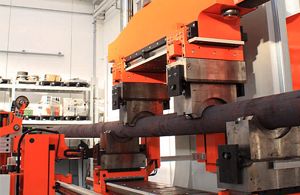-
Product Lines
Material testing machines for quality control

Automatic straightening machines for shafts, profiles

Hydraulic presses, Trimming beading and Automatic production lines

- Company
- Service
- Calibration
- Community
- Contacts
- Library
ISO 6892-1
Products that may be tested in accordance with this standard include metallic sheets and plates, wire, bar or section, rebar, and tubes. Specimens need to be gripped securely ensuring axial alignment in order to minimize bending. The specimen is then strained in tension until failure using either Method A or Method B control modes. During this time, the load, crosshead extension, time, and strain data are recorded to determine the material characteristics. The typical calculations include: Yield Point (Rp, Reh, Rel), Ultimate Tensile Stress (Rm), specific strain values at calculations (A, Agt etc.). ISO 6892-1 also specifies the specimen geometries that should be used depending on the type of product that is being tested
The usual curvature of the hot-rolled specimens requires the use of parallel closing hydraulic grips to assure the perfect clamping and the specimen straightening during the pre-test phase. These grips are effective to avoid that the calamine on the specimen may damage the inserts. For these reasons it is not advisable to use wedge grips. The machine can be equipped with clip on, contact type and video extensometers. The challenges of testing to this standard are:
Using advanced controller technology, it is possible to achieve up to a 40% decrease in test time using Method A Closed Loop Strain Control, ultimately improving throughput. When testing to Method B where the strain rate on the specimen will vary system to system, using a stiff Galdabini frame will ensure accurate results for improved comparability across different sites. We suggest a secure Gripping with Hydraulic Parallel type to ensures no slippage occurs. Labtest software has advance pre-built methods available with pre-configured metal-specific calculations helping to ensure compliance
One of the key features for reliable results of metal tensile tests is undoubtedly the accuracy and state of the art layout of the extensometers. These are not only used to acquire measured values, but are also used as the reference for the strain control in the important method A. We differ from other suppliers in that these important features are not purchased but developed and manufactured by us: Extensometer MICRON, MICRON MOTOR, and VideoXT